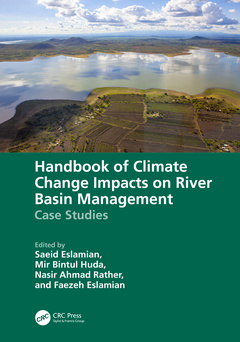Handbook of Climate Change Impacts on River Basin Management Case Studies
Coordonnateurs : Eslamian Saeid, Huda Mir Bintul, Rather Nasir Ahmad, Eslamian Faezeh A.

Climate change not only involves rising temperatures but it can also alter the hydro-meteorological parameters of a region and the corresponding changes emerging in the various biotic or abiotic environmental features.
One of the results of climate change has been the impact on the sediment yield and its transport. These changes have implications for various other environmental components, particularly soils, water bodies, water quality, land productivity, sedimentation processes, glacier dynamics, and risk management strategies to name a few.
This volume presents a diverse collection of case studies from researchers across the globe examining the impacts of climate change on river basin management in various geographical, hydrological, and socioeconomic contexts. The case studies yield important insights that can inform strategies to build resilience and adapt river basins to a changing climate.
Part I: South and North America. 1. Watershed Management Case Studies in USA and Canada. 2. Sediment Yield in Extreme Cold Environments: The Case of the Sagavanirktok River in Arctic Alaska, USA. 3. Regional Precipitation and Streamflow Trends In the Bermejo River Basin in The Context of Global Change in Argentina. 4. Statistical Modelling of Summer Precipitation in the Pampa Region of Argentina. Part II: Africa. 5. Climate Change Impact on Sediment Yield Case Studies in Africa. 6. Basin Management Case Studies in North Africa. 7. Global Climate Change and Free Market Economy Double Exposure Influence on Co-operatives in Tanzania: Hopes and Fears. 8. Assessing Environmental Causes and Its Disaster Risk Management of Erosion in Agulu-Nanka Community. 9. Land Cover/Use Changes and Urban Flood Incidence in Osun River Basin, Southwest Nigeria. 10. Sediment Transport Index and Stream Power Index using GIS: A Case Study in Bou Saâda Wadi-Sub Basin, Algeria. 11. Hydrological Hazard and Climate Change in Arid and Semi-arid Regions. Part III: South Asia. 12. Climate Change Impacts on Water Resources and Sediment Yield in South Asia. 13. Detection of Land Surface Temperature in North West Part of Bangladesh: A Remote Sensing Based Approach. 14. Heavy Metals on the Sediments of Ship Breaking Zone and Impact on Fish Diversity in Coastal Bangladesh. 15. Environmental Impacts on Sediment Load and Bank Erosion in River Channels in Bangladesh. 16. Impact of Climate Change and Human Influence on the Sediment Yield of Indian Himalayan Rivers. Part IV: East Asia. 17. Impact of Large Dams on Local Climate Change: A Case Study on the Three Gorges Dam. 18. Historic Rainwater Harvesting System in Kampong Ayer (Water Village) in Brunei Darussalam. 19. Role of Wetlands in Flood Prevention in Brunei Darussalam: A Case Analysis on Tutong District. Part V: Middle East. 20. Projected Changes in Climate Extremes by High Resolution Regional Climate Model over Türkiye. 21. Time Series Analysis for Watershed Meteorological Data: A Case Study on Temperature Prediction. 22. Irrigation with Superabsorbent Polymer under Drought Stress Condition in a Temperate Arid Region. 23. Wind Drift and Evaporation Losses from Sprinkler Irrigation in a Semi-Arid Climate.
Prof. Saeid Eslamian is a full professor of environmental hydrology and water resources engineering in the Department of Water Engineering at Isfahan University of Technology, where he has been since 1995. His research focuses mainly on statistical and environmental hydrology in a changing climate. In recent years, he has worked on modeling natural hazards, including floods, severe storms, wind, drought, pollution, water reuses, sustainable development and resiliency, etc. Formerly, he was a visiting professor at Princeton University, New Jersey, and the University of ETH Zurich, Switzerland. On the research side, he started a research partnership in 2014 with McGill University, Canada. He has contributed to more than 600 publications in journals, books, and technical reports. He is the founder and chief editor of both the International Journal of Hydrology Science and Technology (IJHST). Eslamian is now associate editor of three important publications: Journal of Hydrology, Eco-Hydrology and Hydrobiology, Journal of Water Reuse and Desalination (IWA) and Journal of the Saudi Society of Agricultural Sciences. Professor Eslamian is the author of more than 40 books and 200 chapter books.
Dr. Mir Bintul Huda (B.Tech, M.Tech, AMIE, Ph.D.) is presently a Consultant at Water Resources Management Centre, National Institute of Technology Srinagar, Jammu & Kashmir. Her work is on Water Resources, Climate Change Impacts and adaptation of strategies with respect to Planning and Management of Water Resources Systems of Indus Basin. Dr. Mir received Ministry of Human Resources Development (MHRD) Doctoral fellowship from Government of India and earned her Doctorate in Civil Engineering with majors in Water Resources Engineering from National Institute of Technology Srinagar. She did her Masters of Technology in Water Resources Engineering from NIT Srinagar. She has done her Bachelors in Agricultural Engineering from Sher-e-Kashmir University of Agricul
Date de parution : 05-2024
17.8x25.4 cm



